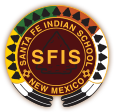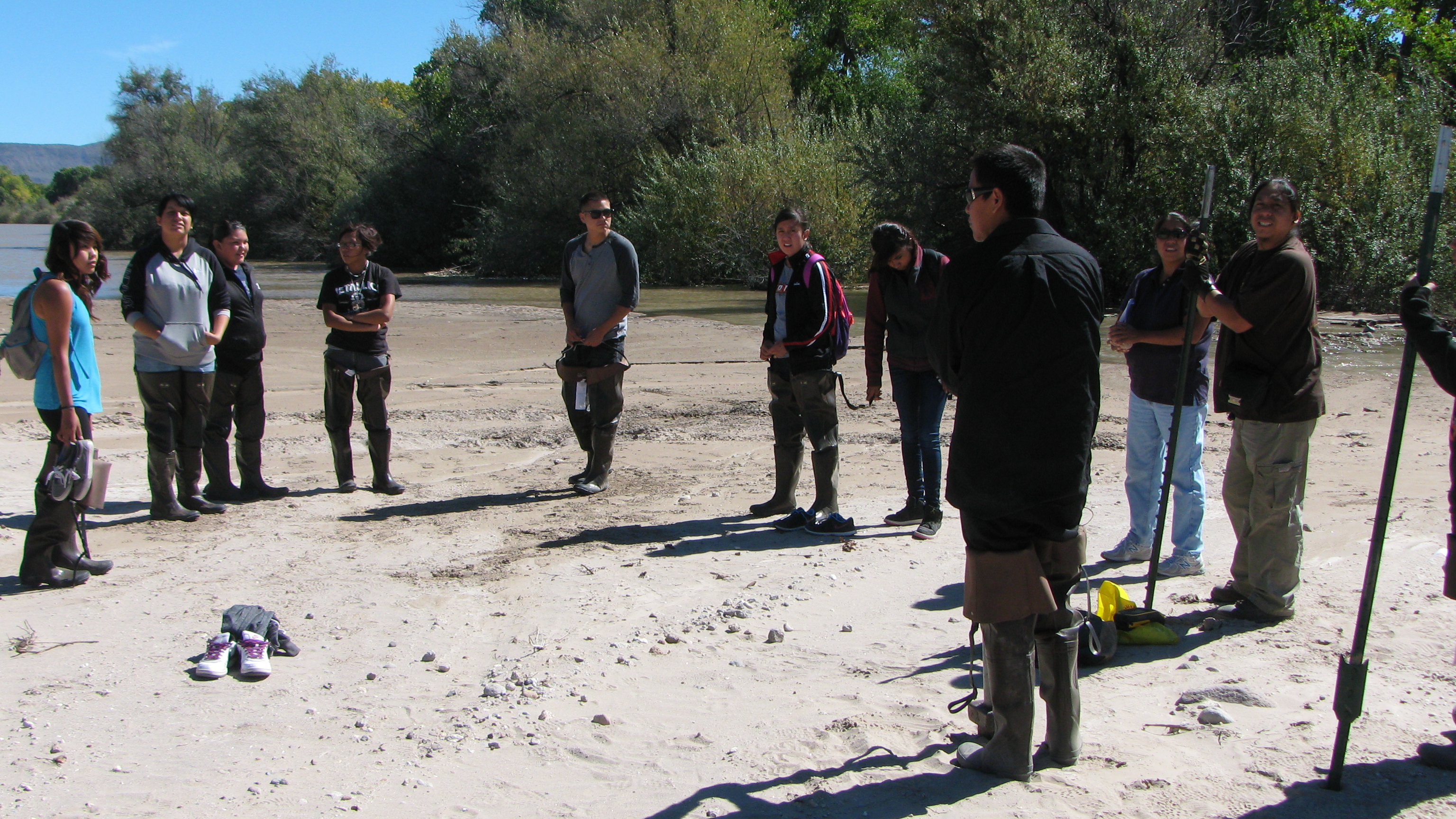Academics
Community Based Education
| What's Going On? |History | Practice | Evolution |
Taking advantage of the mild Fall weather, the students have been busy in the field. This school year we will be continuing to develop environmental monitoring, restoration, and mapping projects in Pueblo de Cochiti, Santo Domingo Pueblo,Tesuque Pueblo, and the Santa Fe River Preserve. Water related projects continue to be central to the community based curriculum, as a range of concerns are being addressed.
Pueblo de Cochiti
Students are participating in a study to cahracterize, map, and assess the environment and habitat at a 1.5 mile reach of the Santa Fe River that has is being studied and restored to better habitat for naive plants and wildlife. In addition, we have been lucky to observe the effects of a rare changing of course of the Rio Grande; a natural event that has not happened since the 1960's because of the dams that have been built. The Las Conchas fire burn scar in Peralta Canyon in Summer 2011 set the stage for a large sediment deposit to push the Rio Grande to the east as a result of the unusual high-volume rains of September.
Alumnus Kai-t Bluesky and Phoebe Suina talk with the students about the September rains that brought
so much sediment down Peralta Canyon that it changed the course of the Rio Grande.
The students are standing in a location that was the bottom of the Rio Grande only a few weeks earlier!
Sim Table
Students will continue to develop the use of the Sim Table to visualize their jurisdictional lands and ancestral domain landscapes. The Sim Table currently allows students to model fires and firefighting. Other models are being worked on with our partners at Simtable.com to address environmental problems realted to flood, pollution and erosion simulation. In addition, students can also visulaize their home community landscapes on the Simtable and create their own shapefile layers to enhance understanding of relationships and processes in teh landscapes.
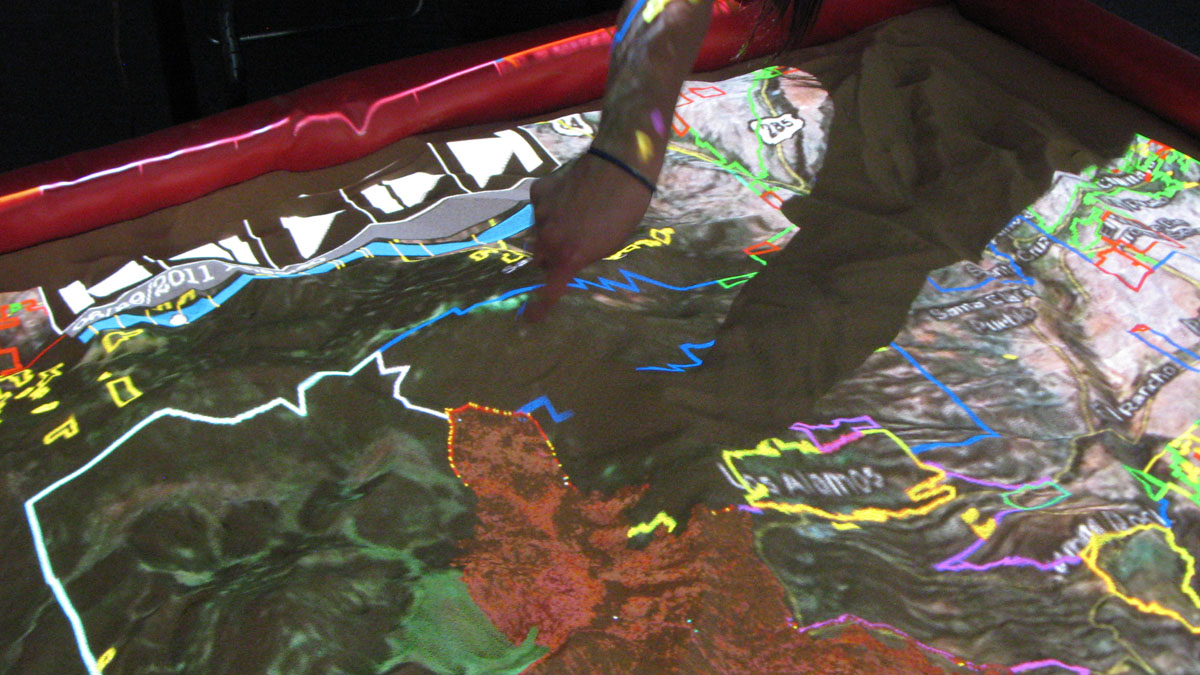
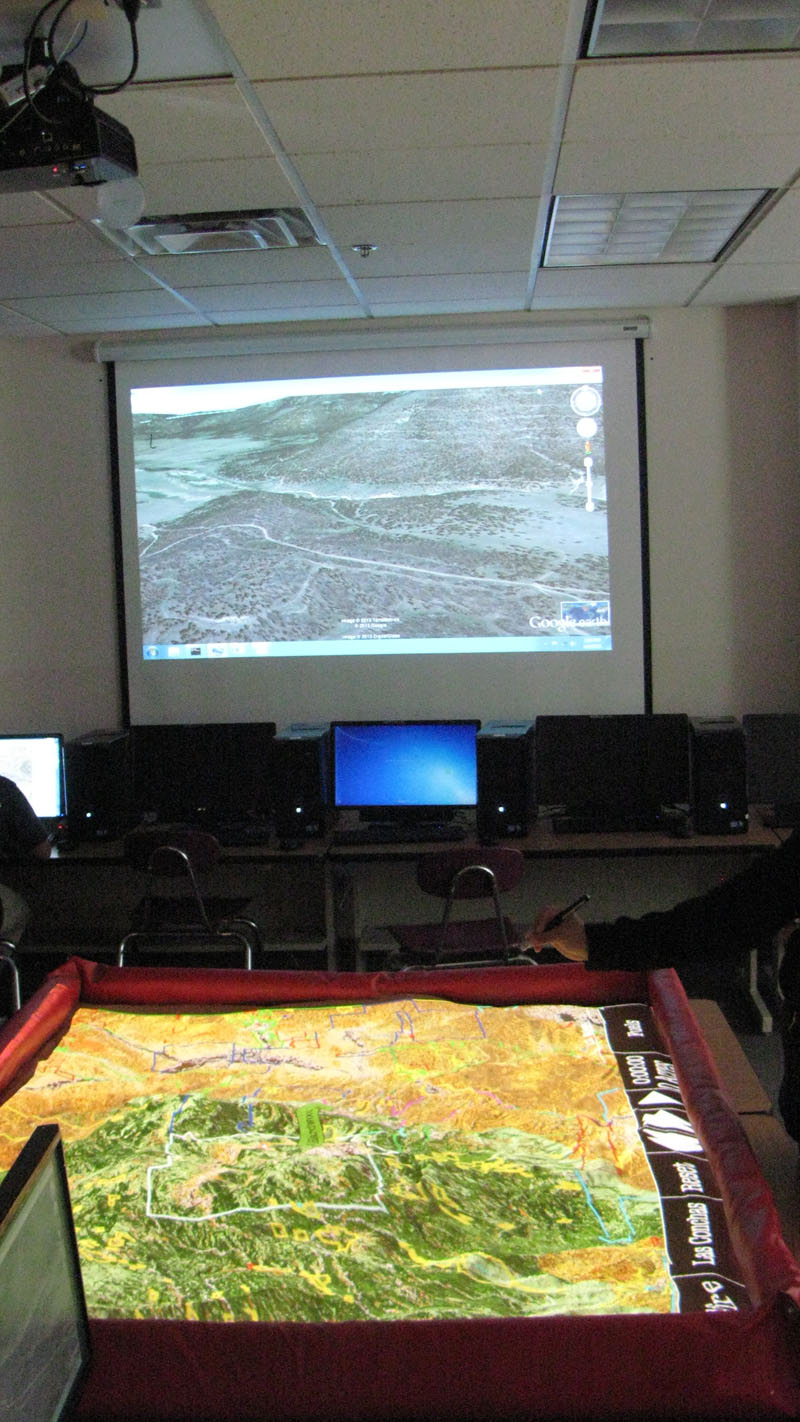
History
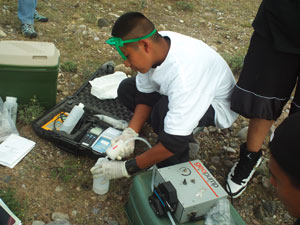 For well over two decades there have been discussions and efforts within the Santa Fe Indian School to make curriculum relevant to tribal community cultural values and traditions. Administrators and faculty members have long involved community members to enhance classroom lessons by incorporating more community context in education. Organizations such as American Indian Science and Engineering Society (AISES) and the Bureau of Land Management, and special projects and grants have involved students in activities that have related education goals to student backgrounds where the goal has been relevant and meaningful educational experiences.
For well over two decades there have been discussions and efforts within the Santa Fe Indian School to make curriculum relevant to tribal community cultural values and traditions. Administrators and faculty members have long involved community members to enhance classroom lessons by incorporating more community context in education. Organizations such as American Indian Science and Engineering Society (AISES) and the Bureau of Land Management, and special projects and grants have involved students in activities that have related education goals to student backgrounds where the goal has been relevant and meaningful educational experiences.
Early efforts set the foundation for the current era of community based education development at SFIS, a process that has led to innovations in community based education recognized and emulated by governments and institutions across the United States and around the globe.
In July of 1995, Community Based Education was established at SFIS based on the collaborative vision of SFIS leaders, Pueblo Governors and educators at the school and in our tribal communities. Facilitated through grants received from the Intel Corporation and the U.S. Department of Energy, the concept was piloted through the Community Based Education Model (CBEM). CBEM sought to engage students with tribal communities on current priorities related to their environment, natural resources and health. CBEM was introduced in grades 10-12 and focused on Math and Science using lecture, technology training and application, and field-based experiences. In 1999, Tribal Government and Communications were integrated into CBEM, making the program a more interdisciplinary approach to learning.
Early on, CBEM established close working relationships with the Pueblos of Jemez, Cochiti, Tesuque, San Ildefonso and Santa Clara, which allowed for mutual interaction in the development of interdisciplinary curricula. This model drew from “circles of wisdom,” meaning the multi-layered practice of wisdom that exists in tribal communities, combining community knowledge with student experiential learning and working towards resolution of community issues and problems. Community Based Education empowers communities as they identify and prioritize areas of exploration and need, and involve tribal members in the development of class activities, taking on active roles as teachers and mentors for students.
| back to top |
Practice
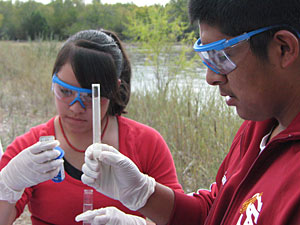 Since 1995, the Community Based Education Model (CBEM), now called the Community Based Education Department (CBED), worked to involve students in community issues, to inspire them to pursue related advanced education and career paths, and apply their knowledge and skills in their own communities. Community based interdisciplinary curriculum helps students develop Science, Math, Civics, and Communications skills in the context of relevant, important and lasting work.
Since 1995, the Community Based Education Model (CBEM), now called the Community Based Education Department (CBED), worked to involve students in community issues, to inspire them to pursue related advanced education and career paths, and apply their knowledge and skills in their own communities. Community based interdisciplinary curriculum helps students develop Science, Math, Civics, and Communications skills in the context of relevant, important and lasting work.
At SFIS, our position is that this approach is effective and empowering education that encourages and supports the development of stronger relationships with stakeholders—families and communities from which the students come. Through its success with community-based education, SFIS has learned that it can foster enduring, positive and productive relationships between students and community members while meeting and exceeding state and national education goals and standards.
The structure that evolved to enable regular student field trips to the communities and the required interdisciplinary approach to understanding complex community issues has worked well. The ability to take students on regular, frequent field trips to our partner communities has been the basic foundation and reason for this structure and it is what makes CBE at SFIS unique and successful.
In community settings, students are regularly involved in work that not only exposes them to field opportunities, but that also serves a direct purpose to our local tribal communities. Examples of student work in partnership with tribes includes,
- Mapping of Agriculture Fields—field boundaries, irrigation systems, soil
- Surface and groundwater monitoring
- Air quality monitoring
- Wetlands restoration and protection
- Developing GIS viewing methodologies for displaying collared elk movement data
- GPS and GIS mapping of water, gas and electric infrastructure in various Pueblo neighborhoods
- Interpretive trail construction and signing
- Riparian photo documentation, species identification and management
- Solid waste management, dump mapping and cleanup, recycling
- Habitat restoration
| back to top |
Evolution
Initiated on a voluntary basis throughout the grades and across the entire curriculum in 2003, and made mandatory in 2005, all SFIS teachers are now supported to develop Community Based Education Units to enhance the learning experience and bring cultural relevancy to the entire SFIS student population.
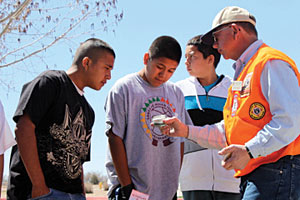 Units range from short-term to year-long and are practiced in single classes by individual teachers, as well as by interdisciplinary teams of teachers. CBE units continue to evolve in scope and depth and do involve consultation and involvement of community members and CBED staff. Over 700 SFIS students have received community based education experiences in all of their classes during the last three years.
Units range from short-term to year-long and are practiced in single classes by individual teachers, as well as by interdisciplinary teams of teachers. CBE units continue to evolve in scope and depth and do involve consultation and involvement of community members and CBED staff. Over 700 SFIS students have received community based education experiences in all of their classes during the last three years.
Based on the success of CBED, there have been many visitors interested in learning about CBE at SFIS. They have come from schools and tribes within the United States, Canada, China, and countries in Europe, South America and Africa. CBE and SFIS staff have made numerous presentations at conferences and workshops over the years. In 2006 SFIS was one of 160 recipients, out of 200,000 sites worldwide, of a Special Achievement in GIS Award from the Environmental Systems Research Institute, makers of the GIS software the program uses. Inquiries and requests for visitations continue. Combined, these exposures amount to a significant impact.
| back to top |
